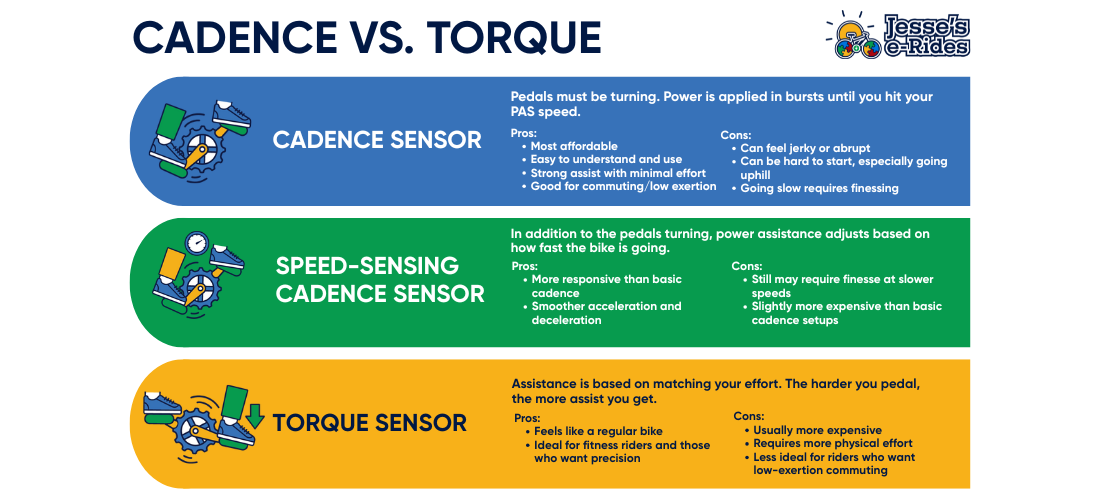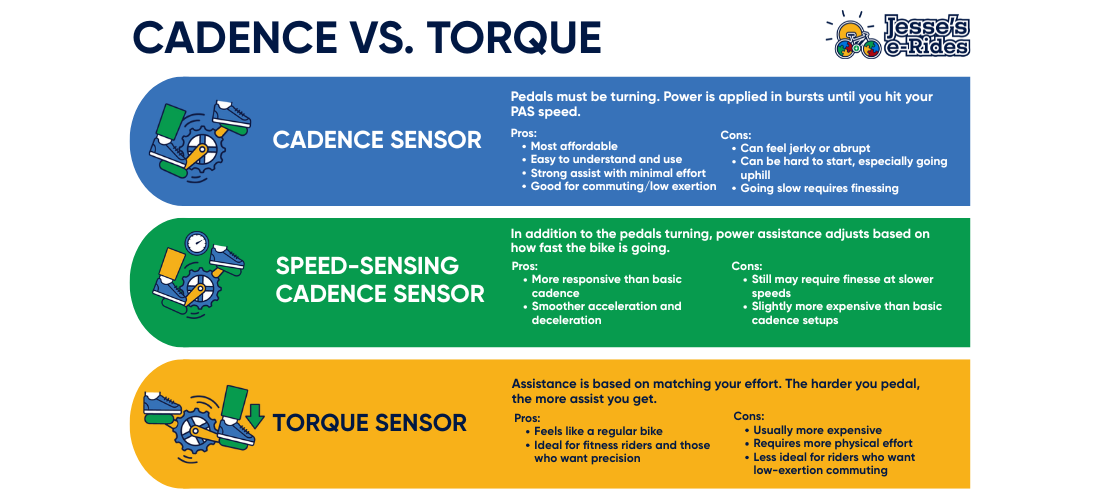
Cadence vs. Torque vs. Speed Sensors: What’s the Difference on an E-Bike or E-Trike? 🚴♀️⚙️
Share
Cadence vs. Torque vs. Speed Sensors: What’s the Difference on an E-Bike? 🚴♀️⚙️
If you're shopping for an e-bike or e-trike, you've probably come across terms like torque sensor, cadence sensor, and even speed sensor. These all relate to how your e-ride detects your pedaling—and how it decides to kick the motor in to give you a boost. So what’s the difference, and why does it matter?
Let’s break it down. 👇
🚵♂️ Torque Sensors: Power Based on Effort
A torque sensor measures how hard you're pushing on the pedals. The harder you press, the more power the motor delivers. It feels smooth and intuitive—the experience that feels most like riding a manual bike.
💪 This is the type of sensor that gives you the most workout. Since assistance is tied to your effort, you're still doing plenty of pedaling—just with support that adjusts as you go.
🚴 Because it closely mimics the feel of a regular bike, torque sensors are often a favorite among fitness riders and those who want a more active e-bike experience.
🌊 Torque sensors are also the smoothest option. The motor responds instantly and proportionally to your effort, with no delay or sudden surges—just clean, natural-feeling support.
😅 Keep in mind: It may not be the best option for commuting unless you’re okay arriving drenched in sweat. Since the motor only kicks in when you apply real pressure to the pedals, you’re still doing the work—and you’ll feel it by the time you get to your destination.
🐢 Want to ride slow, like 7 mph? No problem. Just pedal gently, and you’ll cruise at whatever pace you want. Torque sensors respond to effort—not speed—so you’re fully in control.
🚲 Cadence Sensors: Power Based on Movement
A cadence sensor activates the motor when it detects the pedals moving—regardless of how hard you're pedaling. This means you could barely be pedaling at all and the motor assist will kick in.
🔄 Cadence sensors are commonly found on more affordable e-bikes and trikes. They’re simpler and less expensive to produce, which makes them popular in entry-level models. While some deliver steady, predictable assist, others may feel abrupt or laggy depending on how the motor controller is tuned.
That said, some setups require a full pedal rotation or have a slight delay before the assist kicks in—this might feel a bit jumpy, especially when starting from a complete stop.
📝 Note that cadence sensors bring you up to a pre-set speed based on your PAS (Pedal Assist System) level. For example, PAS 1 might assist up to 10 mph, while PAS 5 could assist up to 20 mph. As long as the pedals are turning, the motor works to get you to—and then maintain—that speed.
🚧 Want to ride slower—say, 7 mph? The motor will try to bring you up to the speed limit for your current PAS setting. So if PAS 1 is set to assist up to 10 mph, it’ll keep pushing until you get there. If you want to cruise below that, you’ll need to work at it—feathering the brakes, adjusting your cadence, or switching to a lower assist level.
⚠️ Note that some riders with limited mobility or strength may find it challenging to get the pedals moving just enough to activate assist, especially if the bike has a delayed or more sensitive activation threshold.
🚶♂️ Cadence-based systems are a good option for commuting. You can ride with very little pedaling effort—especially on higher PAS levels—which means you’re less likely to arrive sweaty or worn out.
⚡ Speed-Sensing Cadence Systems
Some e-bikes and trikes use speed-sensing cadence systems that combine basic pedal movement detection with real-time speed input. These systems measure when you're pedaling and how fast the bike is moving to determine how much motor power to apply.
📈 Unlike basic cadence sensors, these systems take your current speed into account. That means the motor can respond more smoothly—ramping up assist gently when you're starting from a stop, and scaling back as your speed increases. The ride feels more stable, less jumpy, and more responsive to real-world conditions.
🛠️ Speed-sensing cadence systems are often found in mid-range e-bikes and represent a step up from cadence-only designs. They offer more control and comfort without the higher cost or complexity of torque sensors.
🚧 Like other PAS setups, these systems generally aim to bring you up to a pre-set speed based on your PAS level. Maintaining speeds below that target still requires a little finesse, like feathering the brakes or adjusting the assist level.
✅ Great for commuting and everyday riding, these systems provide easy acceleration with very little physical effort—but with a noticeably smoother feel than cadence-only setups.
✅ Pros and Cons Overview
🟡 Cadence Sensor
Pros:
-
Most affordable
-
Easy to use
-
Strong assist with minimal effort
Cons:
-
Can feel jerky or abrupt
-
Less control at low speeds
-
Doesn’t respond to effort
🟢 Speed-Sensing Cadence Sensor
Pros:
-
Smoother than basic cadence
-
Adjusts based on current speed
-
Good for casual commuting
Cons:
-
Still doesn’t account for pedal force
-
Less precise than torque sensors
🔵 Torque Sensor
Pros:
-
Most natural-feeling ride
-
Responds to effort in real time
-
Great for control, hills, and fitness
Cons:
-
More expensive
-
Requires real pedaling effort
🛠️ Which Sensor Is Right for You?
-
Torque sensor: Best for riders who want a natural-feeling ride and responsive control—especially useful on hills or varied terrain. Also ideal for those who want precise control at slower speeds.
-
Cadence sensor: Great for casual riders who prefer consistent motor assistance without much effort—but less precise if you're trying to ride slowly.
-
Speed-sensing cadence system: Ideal for those who want smooth, steady acceleration up to a pre-set speed, especially for commuting or easy riding.
At Jesse’s e-Rides, we’re happy to explain how each system feels in real life and help you test ride different options. Whether you're looking for effortless cruising or more responsive pedaling support, there's a sensor setup that fits your style.
✨ Come try them out and feel the difference yourself!
#ebikes #etrikes #torquesensor #cadencesensor #eBikeTips #jesseerides #3wheelsfromjesse #eRideEducation


 Little Silver, NJ
Little Silver, NJ
 855-88JESSE (855-885-3773)
855-88JESSE (855-885-3773)
 hello@jesseserides.com
hello@jesseserides.com
